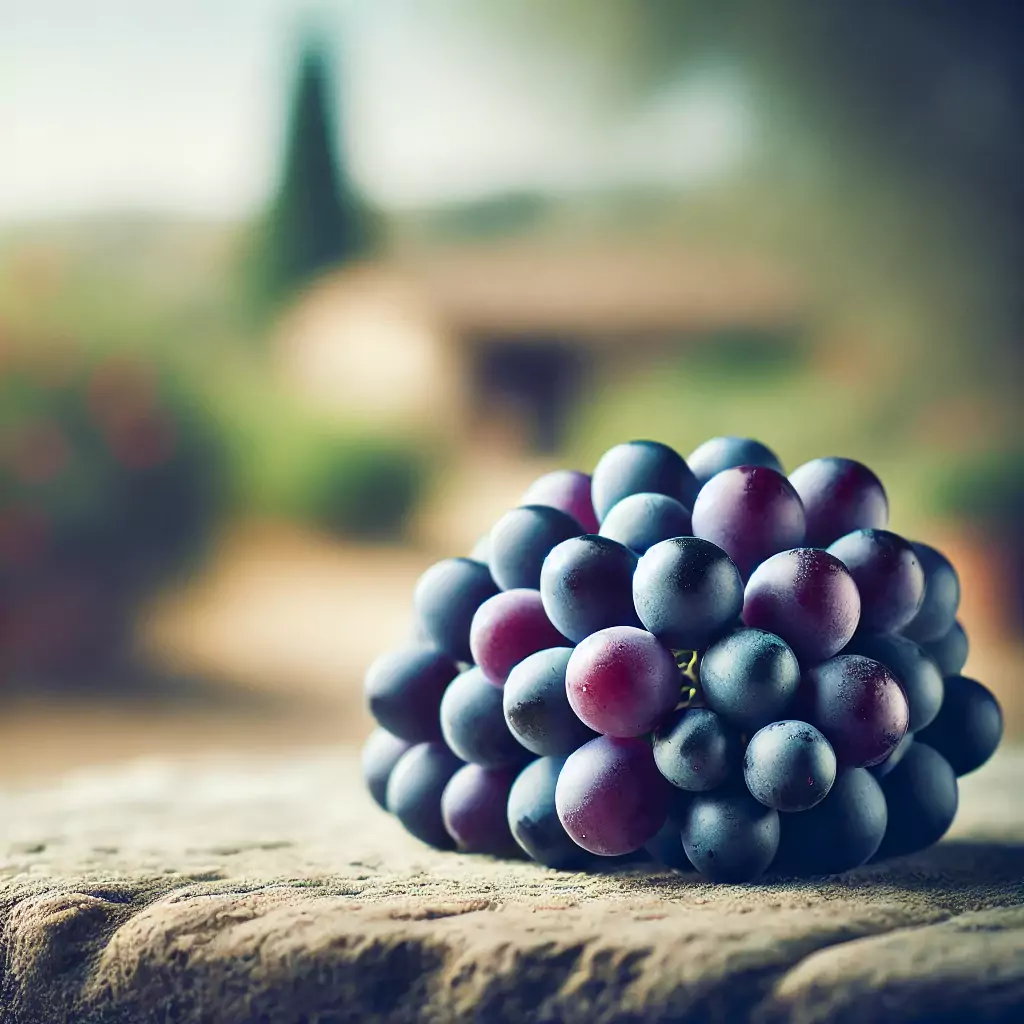Malbec Grapes
History, Characteristics, and Their Impact on the World of Wine
The Origin and Evolution of Malbec Grapes Over the Years
The Malbec grape boasts a rich and fascinating history that spans centuries and continents. Originally known as one of the traditional varieties of the Cahors region in southwestern France, Malbec began its journey to prominence long before achieving the global recognition it enjoys today. While it remains valued in France, its true worldwide acclaim came when it arrived in Argentina, where it found the perfect conditions to thrive and reach its full potential.
The origins of the Malbec grape date back to ancient times in France, where it was cultivated in Cahors under names such as “Côt” or “Auxerrois.” At that time, the grape was prized for producing bold and deep wines known for their dark color and excellent aging potential. During the Middle Ages, wines made from Cahors Malbec were highly popular among European nobility, even becoming a favorite of English monarchs.
However, over the years, Malbec faced challenges in France, including vine diseases like phylloxera and harsh climatic conditions, which reduced its presence in French vineyards.

Despite these setbacks, the Malbec grape did not vanish. In the 19th century, it was brought to Argentina by agronomist Michel Aimé Pouget, who recognized its potential in the fertile lands of the Mendoza region. It was in this South American country that Malbec found its ideal home, thanks to the arid and sunny climate combined with mineral-rich soils, which allowed the grape to flourish exceptionally well. Unlike in France, where its cultivation was limited, Malbec thrived in Argentina and began to be grown on a large scale.
Over time, Malbec became synonymous with Argentine viticulture, and wines produced from this grape achieved international fame. Throughout the 20th century, the popularity of Malbec continued to rise, establishing itself as one of the country’s most important grape varieties. Argentine winemakers refined their cultivation and winemaking techniques, resulting in exceptional quality Malbec wines known for their deep violet hues, intense aromas of red and black fruits, and a perfect balance between acidity and soft tannins.
In recent decades, the global success of Malbec has been unstoppable. Argentine wines, particularly those from Mendoza, have received accolades in international competitions, solidifying Malbec as one of the most beloved varieties among wine enthusiasts worldwide. While its origins lie in France, it is Argentina that now leads global production of this variety, exporting millions of bottles to markets around the globe.
The evolution of the Malbec grape is a clear example of how a grape variety can adapt to different climates and conditions, thriving and evolving over time. Without a doubt, Malbec will continue to be a standout in the world of wine for many years to come.
Enjoy Malbec to Its Fullest with These Premium Glasses
🍇 Perfect for Malbec Lovers: Designed specifically for Malbec, these glasses enhance the aromas and flavors of your favorite red wine, providing the perfect vessel for every sip.
💎 Lead-Free, High-Quality Glassware: Crafted from durable, lead-free crystal, these glasses offer elegance and clarity without compromising on safety.
🎁 Great Gift for Wine Enthusiasts: This set of glasses makes an ideal gift for wine lovers, perfect for birthdays, anniversaries, or special celebrations.
Distinctive Characteristics of the Malbec Grape and Its Influence on Wine Flavor
The Malbec grape is one of the most prominent varieties in the wine world, not only for its ability to adapt to various climates and soils but also for the unique characteristics it brings to the wines crafted from it. Originally from France but now primarily associated with Argentina, Malbec has won over wine lovers worldwide with its distinctive profile in flavor, color, and texture.
One of the most notable features of the Malbec grape is its deep and intense color. Wines made from this variety typically exhibit a dark red hue with violet undertones, unmatched by many other grapes. This rich color is due to Malbec’s thick skin, which is high in anthocyanins, the compounds responsible for its dark tones. This striking visual quality is not only eye-catching but also correlates with higher levels of tannins and phenolic compounds, contributing to the wine’s body and structure.
In terms of flavor, Malbec wines are renowned for their intense fruity aromas, particularly red and black fruits. On the nose, they often showcase notes of ripe plums, blackberries, cherries, and occasionally raspberries. These fruity flavors are typically well-balanced by subtle hints of spices, such as black pepper, and are frequently complemented by floral notes, especially violets. This floral character is a hallmark of the finest Malbec wines, adding elegance that harmonizes beautifully with the robust tannins.
Another distinctive feature of the Malbec grape is its ability to produce medium- to full-bodied wines, making them suitable for pairing with a wide range of dishes. The tannins in Malbec wines are generally soft and velvety, creating a smooth texture on the palate without being overly aggressive. This quality makes them approachable and enjoyable, even for those just beginning to explore the world of red wines.

The Balance of Acidity and Tannins
One of the factors that makes the Malbec grape so highly regarded is its harmonious balance between acidity and tannins. Malbec wines often exhibit moderate acidity, providing a freshness that complements the richness of their fruity flavors. This acidity also plays a vital role in their aging potential, allowing Malbec wines to evolve and develop more complex flavors over time. As they age, these wines can acquire notes of dark chocolate, tobacco, leather, and vanilla, especially when aged in oak barrels.
The Influence of Terroir
Terroir significantly impacts the characteristics of Malbec wines. In cooler climates, such as high-altitude regions in Argentina or certain areas of France, the wines tend to have higher acidity and fresher red fruit notes. In contrast, in warmer areas like the vineyards of Mendoza, Malbec wines are typically more robust and concentrated, with intense black fruit flavors and a richer texture.
This versatility, shaped by terroir and climate, adds depth and diversity to Malbec, making it a favorite among wine enthusiasts worldwide.
Key Wine Regions for Malbec Cultivation
The Malbec grape is globally renowned for its ability to produce high-quality wines, and the regions where it is cultivated play a fundamental role in shaping the final profile of these wines. While its origins lie in France, it is in Argentina where Malbec has found its ideal home. However, other wine regions also contribute to the prestige of this variety. In this article, we explore the most important wine regions for Malbec cultivation, from its French roots to the high-altitude vineyards of South America.
Mendoza, Argentina: The Heart of Malbec
When discussing Malbec, it’s impossible not to mention Mendoza, Argentina. This region is undoubtedly the most famous for Malbec production worldwide. Mendoza’s climatic and geographic conditions are perfect for cultivating this variety. With alluvial soils, a dry climate, and high altitudes providing warm days and cool nights, Malbec thrives in Mendoza, reaching its full potential.
Malbec wines from Mendoza are known for their deep color, intense aromas of black and red fruits, and smooth tannins. The region is further divided into key subregions, such as Luján de Cuyo and the Uco Valley, where altitude plays a crucial role in the quality of the wine. Vineyards in these areas can reach elevations of up to 1,500 meters (4,920 feet) above sea level, allowing for slow, controlled ripening that enhances the concentration of flavors in the grapes.

Cahors, France: The Historical Origin of Malbec
While Argentina is synonymous with Malbec, the grape’s history begins in Cahors, a wine region located in southwestern France. Here, Malbec is locally known as “Côt” or “Auxerrois” and has been cultivated for centuries. Cahors wines are more robust and tannic than their Argentine counterparts, influenced by the cooler climate and clay- and limestone-rich soils.
In Cahors, Malbec wines often have an earthy and spicy character, with notes of plum, leather, and tobacco. Although Malbec is not as widely planted in France as other varieties, it remains an important part of the country’s winemaking tradition, and Cahors wines are renowned for their excellent aging potential.
Colchagua Valley, Chile: A New Home for Malbec
In recent decades, Chile has emerged as a contender in Malbec cultivation, particularly in the Colchagua Valley. While it doesn’t share the same history as Mendoza or Cahors, Chile offers favorable conditions for growing this variety. The Mediterranean climate, with rainy winters and dry summers, along with the valley’s fertile soils, allows Malbec to develop a fresh and fruity character.
Chilean Malbec wines tend to be lighter and fresher than their Argentine counterparts, with pronounced acidity and notes of cherry and raspberry. Although not yet as famous as Mendoza, Chilean wineries are experimenting with Malbec and are gaining recognition in international markets.
California, United States: An Emerging Market for Malbec
In the United States, Malbec has found a niche in some of California’s wine regions, especially Napa Valley. While Malbec cultivation in this region is not as extensive as in Argentina or France, interest in this variety has been growing due to its popularity in the market.
California Malbec wines are often more opulent and full-bodied, with flavors of ripe fruits like plums and blackberries, complemented by oak notes from barrel aging. Napa Valley, with its warm climate and diverse soils, provides ideal conditions for Malbec to produce high-quality wines, which are well-received in the competitive U.S. market.
Gastronomy: Ideal Pairings and Dishes
The Malbec grape is widely celebrated not only for producing exceptional wines but also for its versatility in gastronomy. Wines made from Malbec have a flavor profile that makes them ideal for pairing with a wide range of dishes, from red meats to vegetarian options. The right pairing enhances both the wine and the food, creating a balanced and pleasurable culinary experience. Below, we explore some of the most notable and ideal pairings to enjoy with a fine Malbec.
Red Meats: The Classic Malbec Pairing
One of the most classic and well-known pairings for Malbec wines is with red meats. Thanks to the tannins present in the wine, cuts of meat like ribeye, tenderloin, or beef ribs pair perfectly with Malbec’s structure. The wine’s soft tannins help balance the richness of the meat, while its fruity and spicy flavors enhance the savory notes of the dish.
Argentine Malbec, in particular, holds a special place in the country’s grilling traditions, where the wines are often served alongside barbecued meats. Pairing a glass of Malbec with a juicy grilled steak is a unique experience that highlights the versatility of this variety. The smoky touch from the grill accentuates the plum, blackberry, and spice notes that characterize Malbec wines.
Rich-Flavored Dishes: Stews and Braises
Beyond grilled red meats, Malbec wines also pair excellently with stews and braised dishes. These hearty, flavor-packed meals match beautifully with the medium- to full-bodied structure of Malbec wines. Dishes like lamb stew, beef bourguignon, or chili con carne benefit from Malbec’s ability to balance the intensity of spices and proteins.
The wine’s richness and its capacity to highlight the umami flavors in these dishes make this pairing a perfect choice for colder months, when stews and braises are a staple on the table.
Cheeses and Cured Meats: A Versatile Companion
Cheeses and cured meats are also fantastic choices to pair with Malbec wines. Aged cheeses like cheddar, manchego, or mature gouda complement Malbec’s silky and fruity texture, creating a harmonious contrast between the wine and the saltiness of the cheese. Likewise, cured meats such as serrano ham, salami, or chorizo can enhance the wine’s spicy notes, making this combination an excellent option for a charcuterie board.
This type of pairing is ideal for those seeking a lighter yet flavorful meal, as both cheeses and cured meats help highlight the complexity of Malbec without overshadowing its fruity flavors.

Vegetarian Options: A Pleasant Surprise
While Malbec has traditionally been associated with red meats, it can also be an excellent companion for vegetarian dishes with bold flavors. Malbec wines pair surprisingly well with mushroom-based dishes, such as mushroom risotto or a mushroom pizza. The earthy and umami flavors of mushrooms complement the wine’s dark fruit notes, creating an intriguing and delicious balance.
Additionally, eggplant-based dishes, like moussaka or grilled eggplant, also work beautifully with Malbec wines. The meaty texture of eggplant and its mild flavor allow the wine to shine, while Malbec’s tannic structure balances the dish’s acidity and flavors.
Malbec is more than just a grape variety; it’s a gateway to a world of unique flavors, experiences, and pairings. We hope this blog has given you a fresh perspective on the fascinating universe of Malbec and its many uses in gastronomy. We invite you to keep exploring our page, where you’ll find more engaging articles about wines, their varieties, and how to enjoy every glass to the fullest. Don’t miss our upcoming blogs, packed with tips, pairings, and fun facts that will make your wine experience unforgettable.
